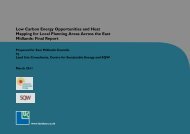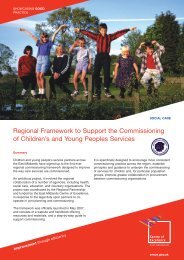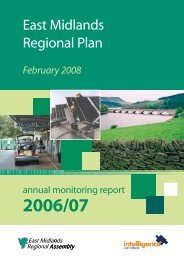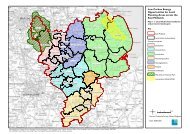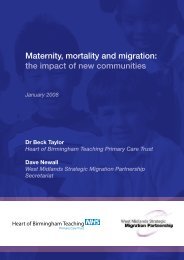East Midlands Regional Spatial Strategy 2005/06
East Midlands Regional Spatial Strategy 2005/06
East Midlands Regional Spatial Strategy 2005/06
You also want an ePaper? Increase the reach of your titles
YUMPU automatically turns print PDFs into web optimized ePapers that Google loves.
Data Analysis<br />
8.39 Although there is no specific number of<br />
affordable houses given in the data, the implications<br />
from the data and the number of houses with<br />
occupancy restrictions demonstrate progress being<br />
made towards providing affordable housing in the<br />
Peak District.<br />
8.40 Employment rates in the High Peak and<br />
Derbyshire Dales are above that for the <strong>East</strong><br />
<strong>Midlands</strong>. Comparison over time is again<br />
complicated by the move to the APS from the LFS.<br />
The ABI data shows that between 2004 and <strong>2005</strong>,<br />
employment in Derbyshire Dales grew by 7.0% while<br />
that in the High Peak fell by 1.0%.<br />
8.41 Two sources of information have been used to<br />
look at the number of visitors to the Peak District and<br />
visitor spend. The STEAM model (Scarborough<br />
Tourism Economic Activity Monitor) provides<br />
estimates for 2003, 2004 and <strong>2005</strong>. However, it covers<br />
the Peak District and Derbyshire county and therefore<br />
overestimates the numbers and spend in the Peak<br />
District. What it suggests is that the average spend<br />
per visitor has remained fairly constant. The data<br />
from the Peak District National Park Survey suggests<br />
much lower spend by day visitors than is estimated in<br />
the STEAM model. The relationship between the<br />
average spend for staying visitors between the two<br />
data sources is more difficult to unravel as one refers<br />
to the spend per stay and the other to the daily spend<br />
per day. What is apparent is that staying visitors<br />
according to the <strong>2005</strong> survey spend approximately<br />
five times more than day visitors, largely due to the<br />
accommodation costs incurred.<br />
Policy Commentary<br />
8.42 There are a host of plans and strategies<br />
covering the Peak Sub-area, either in part or as a<br />
whole. All of these plans are required to help to<br />
secure the conservation and enhancement of the<br />
National Park. Many have either recently been<br />
reviewed or are currently under review.The National<br />
Park Authority is ensuring that the organisations<br />
involved in the production of the plans and<br />
strategies are made aware of the National Park’s<br />
special status when required. All six Local Transport<br />
Plans that cover the Park have recently been<br />
reviewed to cover the period 20<strong>06</strong> to 2011.Three of<br />
these recognise the need to conserve and enhance<br />
the National Park. However, it is reasonable to expect<br />
that recognition of the National Park will vary among<br />
plans according to the extent of coverage of the Park<br />
within their respective areas.The publication of the<br />
new National Park Management Plan for the Peak<br />
District in 2007 will place further emphasis on the<br />
need for partners to work together to ensure<br />
conservation of the Park for future generations.<br />
8.43 In addition to plans, partnerships have and are<br />
being set up to aid conservation of the Peak District,<br />
including the South Pennines Integrated Transport<br />
<strong>Strategy</strong> (SPITS), the Moors for the Future Project and<br />
local rural transport partnerships.<br />
8.44 The social and economic needs of the Peak<br />
District National Park also need to be addressed in<br />
plans and strategies that cover its geography. Several<br />
partnerships exist that attempt to address these<br />
issues, including the Rural Action Zone and the Peak<br />
District Rural Housing Forum.<br />
8.45 The Peak District National Park Authority<br />
monitors housing development in the Park on an<br />
annual basis to assess if the pattern of supply is<br />
sufficient to meet local need without causing undue<br />
damage to the area. In the National Park, annual<br />
dwelling completions remain above the notional 50<br />
identified in the current <strong>Regional</strong> <strong>Spatial</strong> <strong>Strategy</strong>.<br />
Due to the high number of completions during<br />
<strong>2005</strong>/<strong>06</strong> that had restricted occupancy, the average<br />
figure of dwelling completions with an occupancy<br />
condition is now above the RSS target for affordable<br />
housing which equates to approximately 25% of<br />
development.<br />
8.46 With regards to provision for businesses, the<br />
Peak District National Park Authority undertakes a<br />
survey of businesses on a 5 yearly basis in order to<br />
identify need for new premises.The findings of the<br />
survey will inform the Local Development<br />
Framework for the National Park.<br />
8.47 No new road developments are planned to<br />
direct traffic around the National Park at present.<br />
Plans to build a bypass around Mottram and<br />
Tintwistle have been delayed due to the large<br />
number of objections received.The Public Inquiry is<br />
now due to commence in May 2007.<br />
<strong>East</strong> <strong>Midlands</strong> <strong>Regional</strong> <strong>Spatial</strong> <strong>Strategy</strong> Annual Monitoring Report <strong>2005</strong>/<strong>06</strong><br />
151





